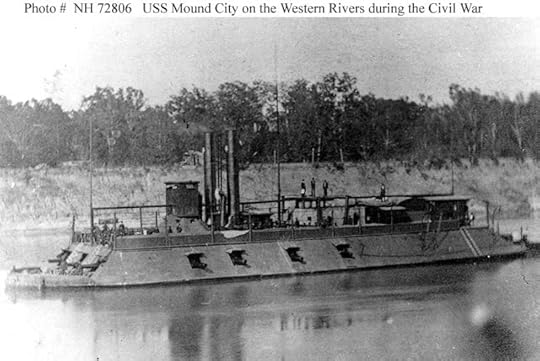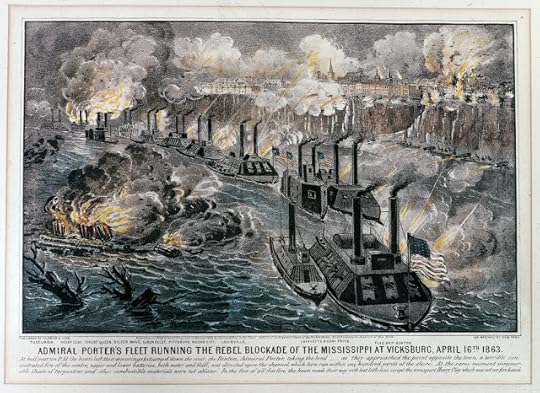Steaming Through A Hornet’s Nest: The Mound City at Vicksburg
Working inthe darkened engine room of the gunboat U.S.S. Mound City, Engineer John M.Hartnett recalled the experience as his gunboat ran the batteries at Vicksburgon the night of April 16-17, 1863.
“For about 30 minutes there was a constant stream of shotwhizzing and shells screeching over and around us, mostly over,” he noted. “Noperson that has never been under fire of batteries can have any idea of thecharming sensation produced by these shells. My position, of course, was in theengine room as it was of all the other engineers so that in case should bekilled or disabled, another could take his place. We were obliged to handle theengine in the dark as no lights were allowed on the ship, which made it verydisagreeable for us as we could not see anything that was going on outside butcould hear distinctly the shots as they passed and those that struck us.”
Engineer Hartnett’s account of runningthe batteries at Vicksburg first saw publication in the May 9, 1863, edition ofthe Waukegan Weekly Gazette.
 The U.S.S. Mound City was built in 1861 by James Eads and featured 2-12" armor over most of the vessel except the stern. Displacing 512 tons, the gunboat featured 13 guns and was manned by a crew of 251 officers and men. Engineer Hartnett's tale of how the vessel was nearly sunk during the Red River campaign the following spring will be featured in a future blog post.
The U.S.S. Mound City was built in 1861 by James Eads and featured 2-12" armor over most of the vessel except the stern. Displacing 512 tons, the gunboat featured 13 guns and was manned by a crew of 251 officers and men. Engineer Hartnett's tale of how the vessel was nearly sunk during the Red River campaign the following spring will be featured in a future blog post. U.S. GunboatMound City
30 milesbelow Vicksburg, Mississippi
April 20,1863
Believing that you have nocorrespondent in the fleet of Admiral [David Dixon] Porter and supposing thatany good news would be welcome. I will endeavor to give you an idea of how weran the blockade, or rather how we fought and passed the renowned stronghold ofVicksburg.
A day or two after we returned fromour expedition up Deer Creek and Steele’s Bayou, while at anchor at the mouthof the Yazoo River, we received orders to place logs on the side of our boatwhere it was not protected by iron. We did so; then orders came for us toreport to the admiral when ready. After putting about 50 bales of pressed hay onour stern and over our magazines we reported as ready on the 13thinstant. From some cause, we were delayed until the night of the 16thwhen we left our rendezvous about 9:30 in the following order: the flagship Bentonwith the Admiral on board, then the Lafayette, General Sterling Price, Louisville,Mound City, Tuscumbia, Carondelet, and the Pittsburg, each boathaving a barge of coal in tow. There were also three transports in the rear whichkept well on the opposite side of the river from the batteries. They wereprotected about their boilers with cotton bales; their names were the HenryClay, Forest Queen, and the Silver Wave. [please see “Running the Vicksburg Batteries in the Forest Queen"]
We floated down, keeping as well as wecould about 300 yards apart. The night was bright starlight; everything seemeddeathly still as if taking a long breath for what was soon to come. All handswere at their various stations waiting for the word to fire. On we went, keepingclose to the Vicksburg side. The first we heard was the roll of the drum; in amoment after crashed a volley of musketry, then the shot and shell began topour in and about each boat as it passed by.
Soon after the volley of musketry we received, the Rebelsmade a very large fire on a raft which illuminated the river so they coulddistinguish every boat perfectly while it blinded us. All we had to shoot atwas the flashes of their guns. I thought we got into a hornet’s nest in that fightat Arkansas Post where I wasfirst introduced to the music of flying shot and shell, but that was nothingcomparatively. Never were guns served more lively than the Rebels handledtheirs.
 The U.S.S. Mound City was fifth in the line of eight gunboats that steamed past the Vicksburg batteries on the night of April 16-17, 1863.
The U.S.S. Mound City was fifth in the line of eight gunboats that steamed past the Vicksburg batteries on the night of April 16-17, 1863. For about 30 minutes there was aconstant stream of shot whizzing and shells screeching over and around us,mostly over. No person that has never been under fire of batteries can have anyidea of the charming sensation produced by these shells. My position, ofcourse, was in the engine room as it was of all the other engineers so that incase should be killed or disabled, another could take his place. We wereobliged to handle the engine in the dark as no lights were allowed on the ship,which made it very disagreeable for us as we could not see anything that wasgoing on outside but could hear distinctly the shots as they passed and thosethat struck us.
We received a shot in a bale of hay,one which glanced on a log, one through our side just forward of our ironplating about 6 feet above the gun deck. This last shot in passing through theship cut off an oak stanchion eight inches square, through a ventilator, outthe opposite side, doubling over as if it were tin 2-1/2” iron, falling intothe coal barge. Another shot struck the coal barge just above the water line.The shot that went through us wounded four men by splinters, all of whom willrecover.
All the boats were struck more or less. The Lafayettereceived 10 shots through her; I have heard of only one man being killed. The Louisvilleat one time ran against the shore under the batteries. The Rebels ran down thebank with planks to board her; she swung around and gave them her broadsideguns, loaded with grape and canister, and mowed them down right and left. TheTuscumbia also ran aground but got off all right. It seems that the greatlight blinded the pilots.
We might have passed the batteries inhalf the time but that was not altogether the object; it was to fight and passthem contemptuously. So, I don’t want it said that we ran the blockade.The transport Henry Clay was burned; the Forest Queen had one ofher steam pipes shot away and was towed to the other side of the river belowVicksburg and left to repair. The Silver Wave came down all right. Afterwe had passed Vicksburg a few miles, we stopped to see if all the boats weresafe before we passed the Warrenton batteries. All got in line again andsteamed down to Warrenton, running close in shore, when they opened on us withall vengeance. We poured it into them hot and fast and they soon dried up. Ithink they were badly scared as they fired but a few shots.
Our next fight will be at Grand Gulf25 miles below. The intention is to pass the batteries and fight them upstream.They have some very heavy guns there- four from the Indianola aremounted there. The remains of the Indianola lie partly above water onthe other side of the river from us. The Rebel story was that they raised herand had her in fighting trim; it is not so. I expect we will move down theriver tomorrow. We have plenty of hot work ahead; there are four Rebel rams alittle ways below us. The only way for us to get out now is to fight out. Weare now between Vicksburg, Port Hudson, and Grand Gulf.
Source:
EngineerJohn M. Hartnett, U.S.S. Mound City, Waukegan Weekly Gazette(Illinois), May 9, 1863, pg. 2
Daniel A. Masters's Blog
- Daniel A. Masters's profile
- 1 follower



